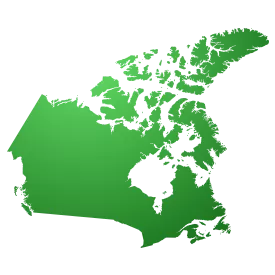Canada


Discover Canada
Currency
Canadian Dollar
Capital
Ottawa
Languages Spoken
English and French
Fun Foods
Poutine, Montreal Smoked Meat, Lobster, Nanaimo Bars, BeaverTails, and Maple Syrup
Canada, a country in North America, is the second largest in the world by area. It spans six time zones, covers roughly 10 million square kilometres, and its capital is Ottawa. Its landscapes range from Arctic tundra to coastal rainforests and sweeping prairie fields.
For thousands of years, First Nations, Inuit, and Métis communities shaped these lands. They fished, hunted, and traded across forests, lakes, and Arctic ice. Their art, languages, and governance systems still inspire Canadians today.
In 1608, Samuel de Champlain founded Québec City and built alliances with local tribes for fur trading. French settlers brought their language, faith, and farming methods to the St. Lawrence Valley. That mix created a distinct French-Canadian culture.
After the Battle of the Plains of Abraham in 1759, Britain took control of New France. British law and institutions replaced French ones, but many settlers stayed and protected their language. This tension still shapes Canada’s bilingual heritage.
Between 1812 and 1814, British troops, Indigenous warriors led by Chief Tecumseh, and Canadian militias defended against a US invasion. The fierce fight at Lundy’s Lane proved Canada’s resolve. It also deepened ties between Indigenous allies and settlers.
On July 1, 1867, Ontario, Quebec, New Brunswick, and Nova Scotia formed the Dominion of Canada. Sir John A. Macdonald, the first prime minister, pushed to link the coasts. His vision drove the building of the Canadian Pacific Railway, completed in 1885.
Métis leader Louis Riel led uprisings in 1869 and 1885 to defend Métis land rights. His trial and execution divided Canadians on justice and identity. Manitoba joined Confederation as a result of those uprisings.
Women earned the federal vote in 1918 after tireless campaigning. Canada sent over 600,000 soldiers to World War I and more to World War II, forging a reputation for bravery on battlefields far from home.
The Indian residential schools forced Indigenous children to abandon their languages and cultures. Canada now confronts this legacy through truth and reconciliation efforts, seeking healing and justice.
In 1970, Quebec’s FLQ Crisis rattled the nation when radicals kidnapped public figures. The government invoked the War Measures Act to restore order. Those events prompted debates on civil rights and unity.
Expo 67 in Montreal dazzled millions with pavilions from around the globe. The 1976 Summer Olympics also left a lasting footprint on the city’s skyline. Later, Vancouver hosted the Winter Olympics in 2010, showcasing Canada’s love of sport.
Canada celebrate Canada Day on July 1 with fireworks, music, and barbecues. Thanksgiving in October gathers families around turkey and pumpkin pie. In Québec City, the Winter Carnival lights up February with ice palaces and sled races.
Hockey unites communities across the country, while lacrosse stands as our official summer sport. From coast to coast, stadiums roar when teams compete for national pride.
See the Rocky Mountains, Niagara Falls, and the northern lights in Yukon. Taste poutine, fresh seafood, and sweet maple treats.
Experience Points


XP EARNED OUT OF 0
Points Breakdown
| Sticker Collected | 0 XP |
| Card Collected | 0 XP |
| Bonuses | 0 XP |
| Total | 0 XP |
Your travel history

First Visit
---
Last Visit
---
You've logged 0 visits.
Sticker Collection

Montreal
Named after Mount Royal, it held the first hockey game in the world in 1875.

Toronto
Take in the views from the CN Tower, then enjoy some time at the Hockey Hall of Fame.

Vancouver
Explore Stanley Park, one of the largest urban parks in the world.

Banff National Park
Established in 1885, the park's glaciers and icefields are some of the largest in the Rockies.

Bruce Peninsula National Park
Explore stunning landscapes and diverse wildlife in this nature lover's paradise.

Cape Breton Highlands National Park
Explore stunning landscapes and diverse wildlife.

Gaspésie National Park
Hike alpine trails, spot caribou in their southernmost range, and uncover ancient geology shaped by glacial forces.

Horseshoe Falls
More than 90% of the water flowing at Niagara goes over this 167-foot tall waterfall.

Jasper National Park
Located north of Banff, the park, established in 1930, protects the beautiful forests and mountains in the province of Alberta.

Mont-Tremblant National Park
Explore the first national park in Quebec, offering stunning landscapes and outdoor adventures for families.

Pacific Rim National Park Reserve
Located along the Pacific Coast, its rugged coastline and temperate rainforests have been protected since 1970.

Prince Edward Island National Park
Established in 1937, the park protects the vulnerable northern beaches, dunes, and marshes on the island.

Waterton Lakes National Park
Explore stunning landscapes, wildlife, and the historic Prince of Wales Hotel in this beautiful national park.

Yoho National Park
A stunning national park with breathtaking landscapes, vibrant lakes, and towering waterfalls perfect for family adventures.
